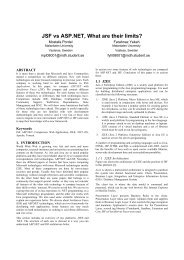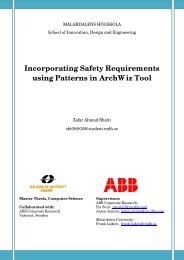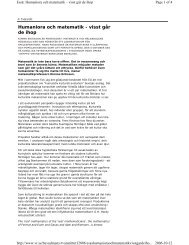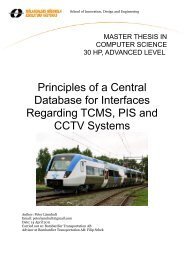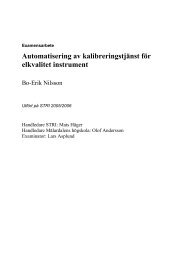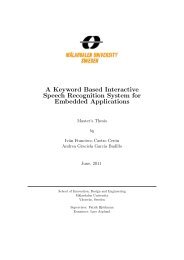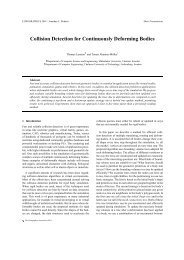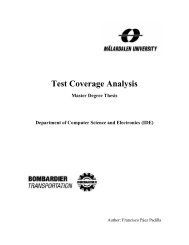Implementation of data collection tools using NetFlow for statistical ...
Implementation of data collection tools using NetFlow for statistical ...
Implementation of data collection tools using NetFlow for statistical ...
You also want an ePaper? Increase the reach of your titles
YUMPU automatically turns print PDFs into web optimized ePapers that Google loves.
2 Theoretical background<br />
RFC 1930 provide guidelines in the decision-making <strong>of</strong> whether or not one would need an own<br />
public AS. In essence, it is only needed if the AS is connected to other ASes (i.e. multi-homed) or if<br />
the routing policy differs from the service provider. If not, the AS should be placed in an AS <strong>of</strong> the<br />
provider. [20]<br />
“An AS is a connected group <strong>of</strong> one or more IP prefixes run by one or more network operators<br />
which has a SINGLE and CLEARLY DEFINED routing policy.” [20]<br />
BGP<br />
BGP is the primary routing protocol on the Internet and the most commonly used <strong>for</strong> EGP routing.<br />
It became the most prominent protocol partly <strong>for</strong> being a very reliable protocol as well as being<br />
very scalable. As <strong>of</strong> this thesis, the BGP routing table consists <strong>of</strong> just above 400.000 routes (see<br />
illustration 14). BGP is also able to merge several routes into one or more routes in a process called<br />
supernetting, which saves memory by keeping the size <strong>of</strong> the routing table down.<br />
As an EGP routes between ASes, the amount <strong>of</strong> network chatter must be kept to a minimum to<br />
allow <strong>for</strong> better use <strong>of</strong> the available bandwidth. This is why BGP, unlike some protocols, do not<br />
send periodic updates about the network topology. BGP instead notifies its neighbors about a<br />
downed network when the event occurs. This method <strong>of</strong> updating the network topology is known as<br />
triggered updates.<br />
BGP works by establishing connections to other BGP neighbors, called peers, on TCP port 179.<br />
Once successful, BGP begins by transmitting its entire routing table to its neighbor, unless stated<br />
otherwise. Any further updates will be by triggered events only. It sends a keep-alive message every<br />
30 seconds to ensure the connectivity <strong>of</strong> its neighbors. If the timers expire and no connection to a<br />
neighbor is re-established, the route is marked as down and removed from the routing table<br />
followed by a triggered update to its neighbors.<br />
BGP differs from the other routing protocols by neither being classified as a distance-vector<br />
protocol or a link state-protocol. BGP bases its routing decisions on attributes instead. These<br />
attributes are divided into groups <strong>of</strong> well known mandatory and discretionary [54][55]:<br />
• Well known mandatory<br />
Must appear in every UPDATE message and must be supported by every BGP s<strong>of</strong>tware<br />
implementation.<br />
• AS_PATH: The AS_PATH attribute is a list <strong>of</strong> all the ASes a particular route has to take<br />
to reach its destination. Separated by spaces, this list can contain several ASes if the<br />
distance is big enough.<br />
• ORIGIN: The origin attribute indicates how BGP learned about a particular route.<br />
Allowed values are IGP, EGP or Incomplete.<br />
• NEXT-HOP: The EBGP next-hop attribute is the IP address that is used to reach the<br />
advertising router.<br />
17



